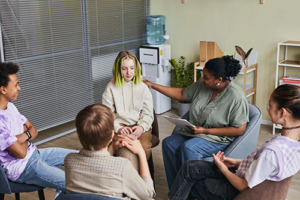How a Youth Counsellor establishes a safe space for open communication
Checking Out the Various Sorts Of Treatment Readily Available for Teenagers With a Therapist for Teens
Teens encounter one-of-a-kind challenges that can impact their psychological wellness. Numerous healing approaches are tailored to address these concerns effectively. From Cognitive-Behavioral Treatment (CBT) to Art Treatment, each technique offers distinctive benefits. Recognizing these therapies can assist caretakers make educated choices. What factors should be considered when selecting the best method for a teenager? The expedition of these various treatments discloses insights that can considerably improve adolescent well-being.
Recognizing Cognitive-Behavioral Treatment (CBT) for Teens
Cognitive-Behavioral Treatment (CBT) works as a powerful device for addressing the unique psychological health challenges encountered by teenagers. This evidence-based technique concentrates on the interplay between ideas, feelings, and actions, helping teens identify and transform unfavorable thought patterns that add to their battles. With structured sessions, specialists guide young adults in identifying their cognitive distortions, promoting much healthier coping mechanisms and psychological law.
CBT is especially reliable in taking care of anxiety, clinical depression, and behavior issues, as it furnishes teens with functional skills to navigate their day-to-days live. The therapy urges self-reflection and promotes a positive state of mind, equipping teens to take control of their psychological health journey. By setting specific objectives and utilizing different strategies, such as journaling and role-playing, CBT promotes resilience and self-awareness. On the whole, this therapeutic strategy gives teenagers with essential tools to challenge their obstacles and construct a much more positive expectation on life.
The Advantages of Dialectical Actions Treatment (DBT)
While several therapeutic approaches supply beneficial understandings for teenagers, Dialectical Behavior modification (DBT) stands apart for its performance in addressing psychological policy and social obstacles. Created by Dr. Marsha Linehan, DBT incorporates cognitive-behavioral strategies with mindfulness methods, making it specifically ideal for teenagers grappling with intense emotions. This therapy aids teens determine and understand their feelings, promoting healthier actions to stress factors.
Among the substantial advantages of DBT is its concentrate on building skills in 4 vital locations: mindfulness, social efficiency, distress tolerance, and emotional guideline. These abilities equip teenagers to deal and navigate complex partnerships with difficult scenarios a lot more effectively. Additionally, DBT motivates a solid therapeutic partnership in between the therapist and the teenage, fostering trust fund and visibility. Consequently, numerous teenagers experience enhanced psychological security and enhanced coping devices, eventually bring about a much more satisfying life and stronger partnerships with peers and family members.
Checking Out Art Treatment as an Innovative Electrical outlet
Art treatment provides young adults a special avenue for self-expression and psychological expedition (Youth Counselling). Through different techniques and techniques, it allows them to interact sensations that might be hard to articulate vocally. By participating in innovative activities, teenagers can experience healing benefits that advertise mental health
Advantages of Art Treatment
Taking part in art treatment offers teens with a special imaginative electrical outlet that fosters emotional expression and individual understanding. This restorative approach allows teens to connect feelings and experiences that might be tough to verbalize verbally. Through different kinds of creative expression, such as drawing, paint, or sculpting, teenagers can discover and process intricate feelings, bring about boosted self-awareness. Additionally, art treatment promotes leisure and tension alleviation, offering a secure space for people to release stifled emotions. The non-judgmental setting urges experimentation, assisting teens construct confidence in their creative thinking and problem-solving skills. As a result, art therapy can improve general psychological wellness, giving an important device for dealing with life's difficulties throughout this crucial developing stage.
Methods and Techniques
When discovering art treatment as a creative outlet, different techniques and techniques can be utilized to facilitate emotional exploration and expression. These may include drawing, painting, sculpting, and collage-making, enabling teens to communicate sensations that might be difficult to verbalize verbally. Guided images can also be utilized, encouraging individuals to imagine and create representations of their emotions. Additionally, the incorporation of songs or movement can boost the imaginative process, promoting a deeper connection to their inner experiences. Group art tasks supply opportunities for social communication and shared recovery. Significantly, the focus in art treatment lies not on artistic skill yet on the process of creation, empowering teens to find their own one-of-a-kind types of self-expression and understanding.
Art as Expression
Imagination serves as a powerful conduit for self-expression, particularly for teenagers maneuvering intricate emotions. Art treatment supplies an one-of-a-kind outlet for teens to explore and interact feelings that may be challenging to verbalize vocally. With attracting, painting, or sculpting, teens can envision their inner struggles, cultivating a feeling of understanding and release. This restorative method permits for personal analysis and motivates exploration without judgment. Furthermore, taking part in creative activities can improve self-esteem and promote emotional durability. As teenagers produce, they may discover new viewpoints on their challenges, causing recovery and individual development. Eventually, art therapy acts as an essential resource, equipping this teens to navigate their psychological landscapes through creative expression.
The Role of Family Treatment in Teen Mental Health

Advantages of Household Participation

Interaction and Dispute Resolution
Reliable interaction and dispute resolution are vital parts of teenage mental health and wellness, particularly within the context of household treatment. Family therapy gives an organized atmosphere where teenagers can reveal their thoughts and feelings, fostering open dialogue. This healing setting motivates member of the family to actively listen per various other, advertising understanding and empathy. By resolving disputes in a risk-free room, teenagers find out important skills for handling disputes constructively, which can reduce emotional distress. Additionally, these skills improve household characteristics, leading to healthier connections. As teens browse the complexities of their emotions, family treatment outfits them with tools to connect efficiently, resolve problems amicably, and enhance domestic bonds, eventually sustaining their total psychological well-being.
Using Mindfulness-Based Therapy for Stress And Anxiety Reduction
As teenagers browse the intricacies of teenage life, including mindfulness-based therapy can function as a powerful device for stress and anxiety reduction. This therapeutic method emphasizes present-moment awareness, helping teenagers face their thoughts and feelings without judgment. By exercising mindfulness techniques such as deep breathing, body scans, and guided images, teens can learn to manage anxiousness and stress and anxiety better.
Study suggests that mindfulness-based therapy pop over here can boost emotional policy and durability in teenagers, enabling them to cope far better with scholastic stress and social obstacles (Youth Counselling Near Me). Normal technique can result in boosted emphasis, reduced impulsivity, and greater general well-being. In addition, mindfulness promotes a feeling of connection to oneself, advertising self-compassion and decreasing negative self-talk
Integrating mindfulness right into treatment sessions supplies teens useful strategies they can make use of in day-to-day life, empowering them to browse stress factors with higher simplicity and confidence. As an outcome, mindfulness-based treatment becomes an important resource in supporting adolescent psychological health and wellness.
Incorporating Play Therapy for Younger Teens and Preteens
:max_bytes(150000):strip_icc()/what-is-cognitive-behavioral-therapy-cbt-2610410_final1-a83b26973a69405ab2dbbc1c8ecda1f6.png)
Therapists learnt this method produce a secure environment where more youthful teenagers can discover their concerns and establish dealing techniques. By involving in play, these people can better understand their feelings and discover to navigate social communications. Additionally, play treatment can foster strength and problem-solving skills, crucial for browsing the difficulties of teenage years. Overall, integrating play therapy find more can improve the therapeutic process, supplying more youthful teens and preteens with the tools they require to thrive mentally and socially.
Often Asked Inquiries

How Do I Know if My Teen Needs Therapy?
Indications that a teenager might need treatment consist of persistent despair, modifications in behavior, withdrawal from activities or friends, academic decline, enhanced stress and anxiety, substance usage, or trouble dealing with life adjustments. Observing these signs can prompt professional analysis.
What Qualifications Should I Search for in a Teen Specialist?
When looking for a teen therapist, one should prioritize qualifications such as pertinent degrees in psychology or therapy, state licensure, specialized training in teen issues, and experience collaborating with young adults in various therapeutic setups.
How Can I Support My Teenager Throughout Therapy?
To sustain a teen throughout treatment, one ought to proactively pay attention, use support, regard their privacy, and verify their sensations. In addition, fostering open interaction can aid them feel a lot more comfy discussing their experiences and feelings.
What Prevail Indications of Mental Health Issues in Teenagers?
Common indicators of mental wellness problems in teens consist of relentless unhappiness, withdrawal from tasks and good friends, modifications in rest or cravings, trouble focusing, raised irritability, substance abuse, and obvious declines in scholastic performance or self-esteem. (Youth Counsellor)
How Long Does Treatment Normally Last for Teenagers?
Treatment period for teenagers commonly varies, typically lasting from a couple of weeks to numerous months. Factors affecting this timeline include the individual's specific requirements, the type of treatment, and progression made throughout sessions.
From Cognitive-Behavioral Treatment (CBT) to Art Treatment, each method uses distinctive benefits. Cognitive-Behavioral Treatment (CBT) serves as an effective tool for resolving the one-of-a-kind psychological health and wellness difficulties dealt with by teenagers. Involving in art therapy offers teens with an unique creative outlet that cultivates psychological expression and individual insight. Family members therapy provides an organized atmosphere where teens can share their ideas and sensations, promoting open dialogue. Research indicates that mindfulness-based therapy can enhance emotional law and resilience in teens, allowing them to deal far better with academic pressures and social obstacles.